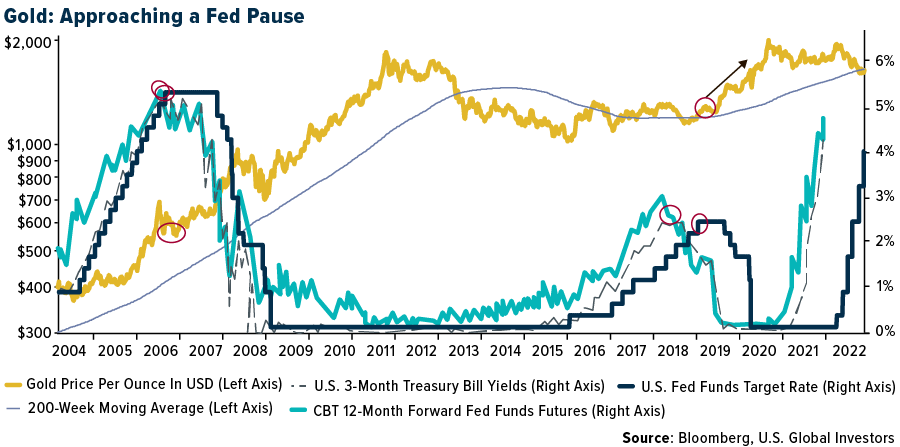Strengths
- The best performing precious metal for the week was silver, up 9.34% largely on speculation that China will reopen soon. According to BMO, Agnico Eagle reported financial results that are in line with, or better than, consensus expectations. For example, adjusted earnings per share (EPS) came in at $0.52 versus the consensus $0.43-$0.44, by outperforming on sales and all-in sustaining costs (AISC).
- India's gold demand has reached pre-pandemic levels and has witnessed an annual growth of 14% during the July-September quarter, at 191.7 tons, mainly driven by strong consumer interest, according to a World Gold Council (WGC) report. The total demand stood at 168 tons during the July-September quarter of 2021.
- Central banks bought a record amount of gold last quarter as they diversified foreign currency reserves, with a large chunk of the purchases coming from as-yet unknown buyers. Almost 400 tons were scooped up by central banks in the
third quarter, more than quadruple the amount a year earlier, according to the WGC. That takes the total so far this year to the highest since 1967, when the dollar was still backed by the metal.
Weaknesses
- The worst performing precious metal for the week was palladium, down 1.86%, perhaps on recession fears. Newcrest Mining reported first quarter 2023 results which featured lower-than-expected production of 527,000 ounces of gold at an AISC that was roughly in line with expectations at $1,098 per ounce. The company mainly attributes the lower production results to its planned maintenance shutdowns during the quarter, lower achieved grades and drought conditions specific to Lihir.
- Eldorado Gold reported third quarter operating and financial results after pre-reporting production of approximately 118,000 ounces earlier this month. Overall, the quarter came with higher cash costs, compounded by a lower realized gold price, and higher income tax expenses, driving a miss to the below-consensus expectations. Production guidance of 460-490,000 ounces was reiterated, with the company tracking to the low-end of the guidance range. Cash cost and AISC guidance have been maintained; however, year-to-date costs are tracking higher than the top-end of guidance, with total cash costs and AISC tracking $62 per ounce and $9 per ounce above the top-end of the respective ranges.
- Gold headed for its seventh straight month of declines, the longest losing streak since at least the late 1960s, ahead of yet another expected jumbo rate hike by the Federal Reserve. The metal extended its October slump on Monday as the dollar and Treasury yields rebounded from last week’s loss amid weakness in equity markets. Attention is now firmly on the Fed, whose aggressive rate hikes have caused bullion to drop more than a fifth from its March peak.
Opportunities
- Silver consumption in India is seeing a rebound in 2022 and is having an impact on its price. Local purchases last year in India were about 4,500 tons but may surpass 8,000 tons, reports Bloomberg. The accelerated purchases have drained the London vaults to 27,101 tons at the end of September, the lowest since records began in 2016. The Perth Mint reported that demand for its gold kilogram bars from Chinese institutional investors have remained at healthy levels over the past two or three months. The imbalance between gold demand and supply in China has the Shanghai gold premium trading about $20 above international prices.
- Are we there yet? U.S. two-year Treasury bond yields peaked at 4.6% in October, in line with the terminal Federal Funds Rate suggested by the September dot plot. The Fed pauses in 2006 and 2018 marked potent entry points for bullion and gold equities. A replay may be in the cards, but risk-averse investors should wait for an inversion of the two-year/three-month bond yield curve as confirmation that a Fed pivot is imminent. However, the large undisclosed central bank gold buying recently, paired with strong institutional demand from Asia, indicates they are not waiting for a Fed pivot.

- Gold could be the most resilient asset to own if the Federal Reserve continues to raise rates, while stocks might be the worst place to be, with non-dollar currencies falling between the two. Gold has had an empirical duration of just over three years in the current Fed cycle, compared with stocks at 7.1 years. The non-dollar currencies that make up the G-10 have seen a duration of 5.3 years. Duration measures the percentage change of an asset in reaction to a 1 percentage point shift in interest rates.
Threats
- Peru’s community of Casma Palla Palla threatened to carry out more protests against Hochschild’s Immaculada mine after 30 protestors burned buildings and attacked company officials at the site earlier in the week.
- Silver Lake Resources’ first quarter 2023 production of 59,000 ounces was 6% below expectations, while group AISC of A$2,052 per ounce was 4% higher. Deflector’s production was the key area of weakness with the company noting that lower-grade stopes were mined during the quarter with the mine also having planned shutdowns.
- UBS forecasts Barrick Gold's net-cash to fall to $400 million in the third quarter and fall again in the fourth quarter, triggering a $0.05 per share decline in the quarterly dividend. Newmont is more complicated, as management envisions reworking both the gold price and cost considerations in its framework, but there may not be an update before the December guidance call. On a simplified basis, the company could cut its dividend by 20%; that said, maintaining the current payout is not out of the question.

